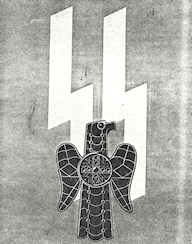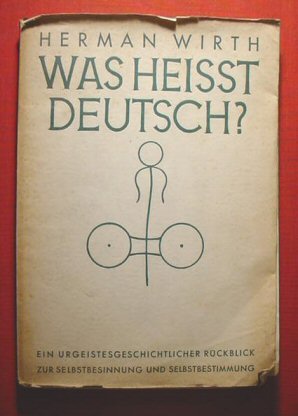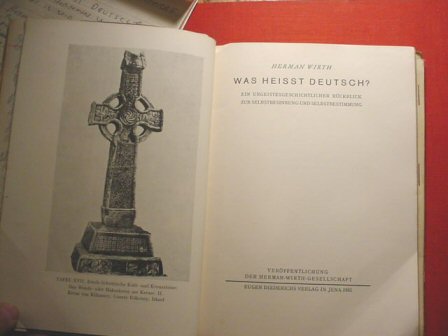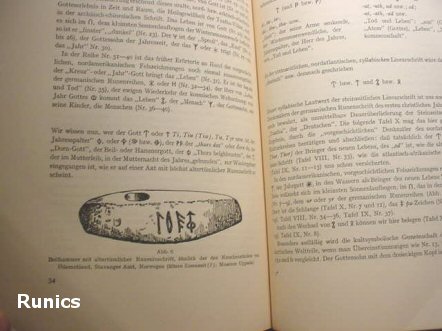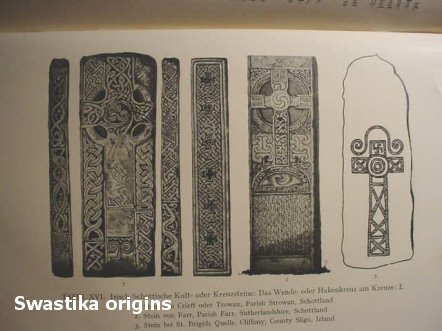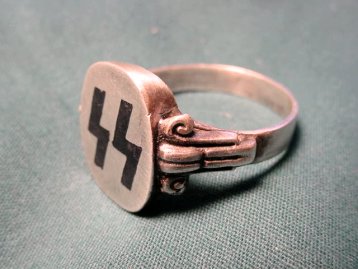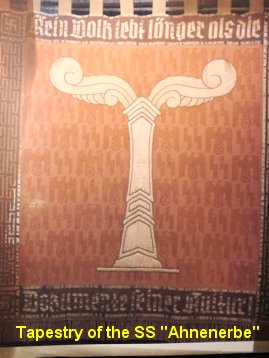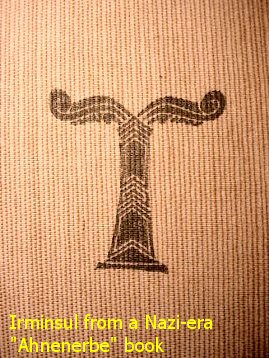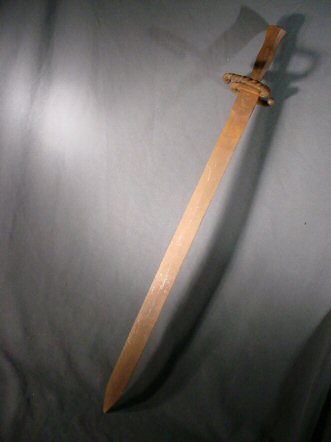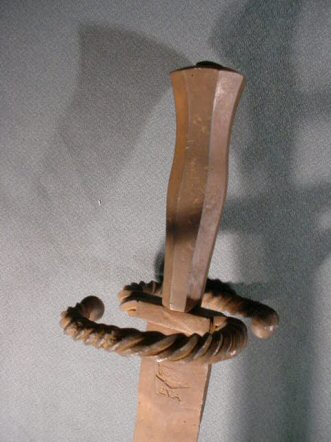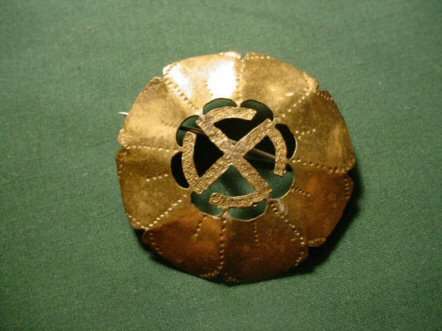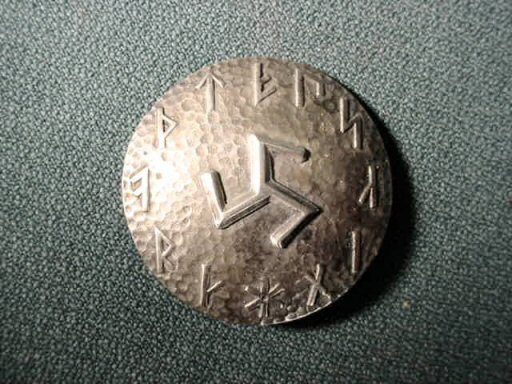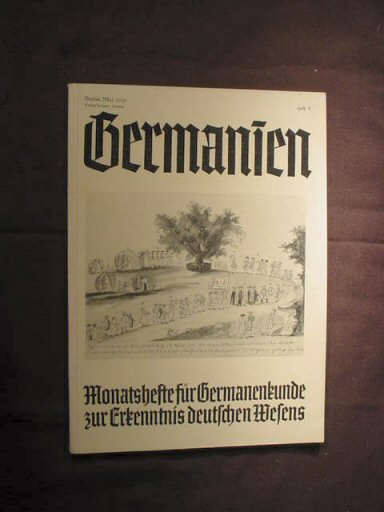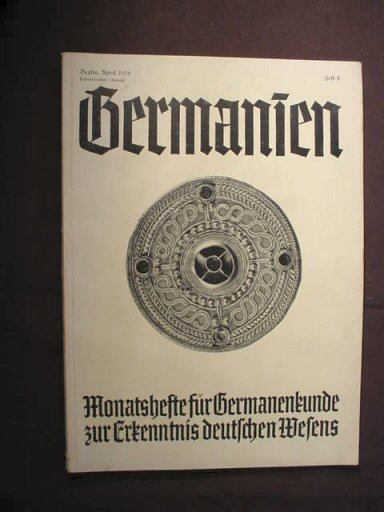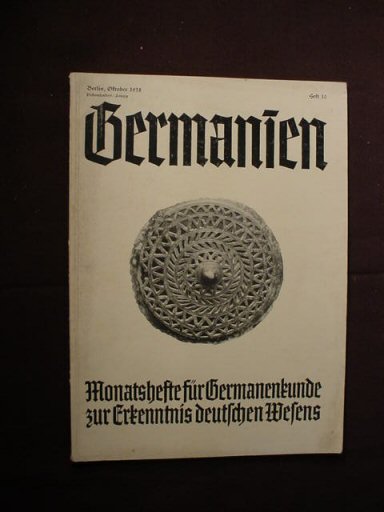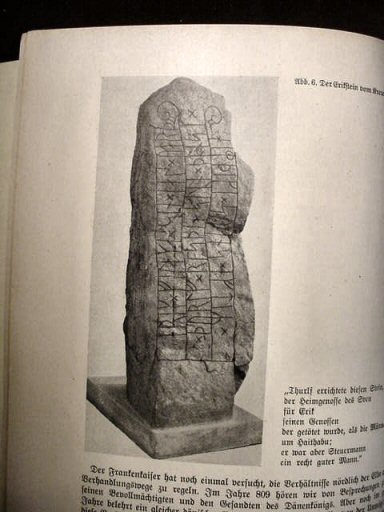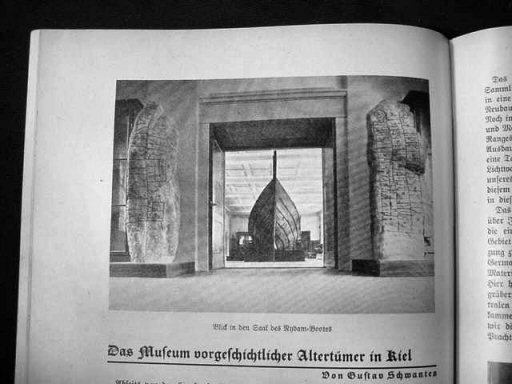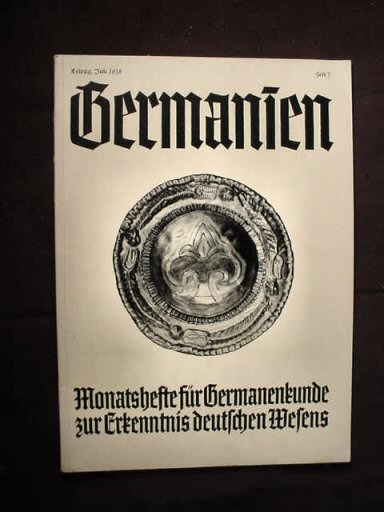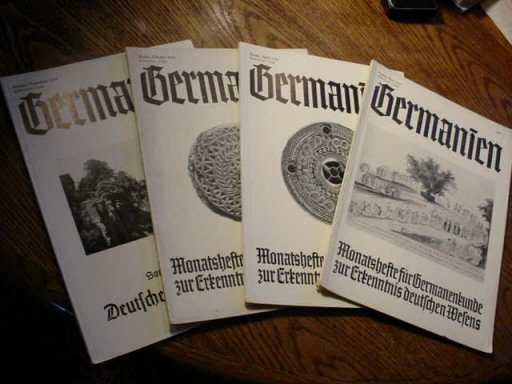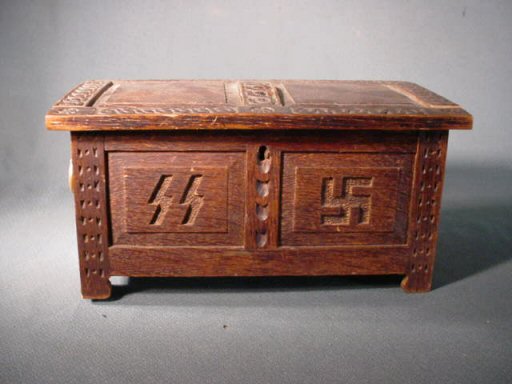|
|
|
|
Book Was Heisst Deutsch?, What is German? by Herman Wirth (Item AHN 2-2)
|
| DESCRIPTION: Herman Wirth was one of the world's greatest archeologists and anthropologists. Dr. Wirth was a Dutch University lecturer who had chosen German nationality and became a volunteer in the German Army from 1914 to 1918. Later, he was known in university circles for his controversial works on the Middle Ages and Germanic antiquity. He joined the NSDAP in 1925 and left it in 1926 only to return in 1933. In these years he wrote the classic work on Teutonic mythology and its impressions on anthropology of the race known as What is the German Soul? Dr. Wirth had the good fortune, so to speak, to meet Heinrich Himmler at the home of mutual friends at a party during the autumn of 1934. At that time they sketched out the outline of a learned society with the name Ahnenerbe, the object of which would be to study and research Germanic antiquity for the purpose of supporting national socialist beliefs by scientific proof. The Reichsführer-SS was very favorably impressed with the idea as fostered by Wirth because it lay so close to his own preoccupations, and the society was set up in 1935 with the status of a learned society. The spirit of the work was summed up in the words of one of the Dutch research experts, who worked with the Ahnenerbe: "After more than a thousand years of the spiritual dictatorship of Judaic Christianity over Europe, we find it necessary to reprove everything!" No domain of human knowledge was to remain extraneous to the organization. The research came under three main headings: Erbe, heritage; Raum, space; and Geist, spirit or mind. In this way prehistory could coexist with geopolitics and philosophy with biology. The works of this organization were profound and many of their papers and studies are used by scientists and archeologists, today. This book by the father and founder of the Ahnenerbe organization is quite rare today and was only circulated in academic circles. It is 60 pages long and then there are 15 more pages separately inserted with charts detailing anthropological evidences of ancient drawings from caves, gravesites, ancient buildings, etc. The book was published in 1931 and was by the Eugen Diederichs Verlag in Jena. It measures 7 x 10 inches. The book is in fairly good shape. The bottom of the back cover is a bit tattered, but holding! The charts are in beautiful condition. As an Ahnenerbe researcher or devotee you can't afford to pass on this one. It's very rare indeed, but certainly affordable from Germania.
PRICE: $380.00
|
|
|
|
SS Pagan Wooden Bowl (Item AHN 2-3)
|
| DESCRIPTION: This is a wonderful hand-carved large wooden bowl that has Ahnenerbe Germanic connotations. The bowl is styled in the manner of the ones used in the sacred grove ceremonies as practiced by the Teutonic tribes such as the Cherusci. The motto around the edge comes from the Nordic Edda. It reads, this "von der Schulter dir Schiebe was Liber dir Schient und Richte dich Selbst nach dir Selber." Basically, this translates to "Throw away from your shoulder that what you think is evil and keep what you think is good." The key word is Dich, 'you.' Almost 14 inches in diameter, it has carved feet for stability. In between the feet there is a logo or runic symbol and it is a wolf's angle and there is a stamp alongside that says, Werkschar, (workgroup). This is a further indication that this is from the Ahnenerbe because the section of this organization that re-created articles from the Teutonic past was called Werkschar. The bowl is quite beautiful and the artists have done a wonderful hammered effect in the interior while the bottom is sculpted with a swirl effect giving an impression of the Sonne Hakenkreutz, or swastika, as used by the ancient Teutons. Here is a Germanophile's dream! Absolutely great!
PRICE: SOLD
|
|
|
|
Superb Ahnenerbe Bowl (Item AHN 2-4)
|
| DESCRIPTION: We have received on consignment a fantastic Third Reich art piece that practically defies the imagination for pure beauty and historic importance. It is a large, oval, hammered silver bowl; almost like a baptismal vessel. The obverse has a depiction of an ancient Nordic Viking-like dragon ship sailing in fleet formation, while the other side bears the 6-headed-beast formation in the mobile design, often seen in Ahnenerbe-designated books. All along the rim are runic symbols that may spell out something dealing with the actual presentation. The plinth is decorated with relief and cutouts in Aryan artistic motif. On the base is a stamped logo with sword in a stylish odel rune with a scroll around it proclaiming “Deutsches Ahnenerbe” in runic letters. This was the official seal of the ancestral heritage trust or Stifftung. This, as we know, was the passion of Heinrich Himmler, the Reichsführer-SS. There were over 50 departments in this organization all striving to bring about the advancement of Germanic culture through intensive studies of the Indo-Germanic beginnings of western man. There were anthropological studies, architectural promotion under N.S. guidelines, and there was s section that taught and practiced construction of treasured Teutonic creations and re-creations such as swords, shields, pottery, jewelry, etc. Many of these items were slated for eventual display in the proposed Ahnenerbe Museum that would have been part of the complex at the Wewellsburg. Some of the items were carefully researched museum re-creations, while others were artistic creations that, while they always were reminiscent of the Germanic past, they included thought and projections for the future of the Ewige Reich! This may be just such an idea put forth in majestic elegance while recounting historical epochs and actually delving into the mythos of the N.S. Glaube (beliefs). The Ahnenerbe expeditions to Tibet are recalled vividly and one cold even say that the shape of the bowl and its Nordic yet eastern look, particularly in the base or plinth, might possibly indicate some connection with these thrilling ventures into the bonds of ancient history-east meets west-so to speak. The Ahnenerbe was a very complex organization with far-reaching implications to the past and future. Dimensions of the bowl are as follows: opening is 12 ¼ x 16 3/8 inches; base is 6 ½ x 9 inches; height is 7 3/8 inches. Germania International, LLC in its desire to bring you the finest and most esoteric of historical items is now extremely proud to offer this exquisite, beautiful, and vastly important rendering that now emerges from the turbulent time of the Third Reich. Here it is in all its glory. Now it is up to you to take it to your special showcase (brightly illuminated) to show it off as possibly the most prestigious N.S. relic that could ever be achieved. The sacrifice of the present owner will be the great gain of the fortunate buyer.
PRICE: SOLD
|
|
|
|
Irminsul SS Ring (Item AHN 2-5; SS 2-5)
|
| DESCRIPTION: This is one of the most interesting rings of the SS. We believe it had something to do with the ancestral heritage study group Ahnenerbe. There are a couple of reasons for our speculation. Unlike some of the other rings that came in the huge collection bought in Stuttgart, there was no bench identification for these when found. We do know that at least one of the jewelry manufacturers in Ludenscheid, where these were found, had the Ahnenerbe contract. The other ring, with the odd runic design, was easy to identify because there were labels and bin identification. Unfortunately, this one must go on a degree of speculation, but there is a strong case for the possibility and probability. The top of the ring has the shape of a runic planchet as used by the ancients in foretelling futures and was used in other Pagan ceremonies and rituals. We know that the Ahnenerbe did not have any particular uniform, but several pieces of jewelry to include rings, stickpins, and brooches, did exist. The most convincing aspect of this Ahnenerbe connection is evident in the design of the shank of this ring. To each side of the runic top are motifs that appear to depict a symbol that was important to this SS organization, that was always cloaked in mystery. This was the Irminsul, tree of destiny, Wotan's monument. This immediately became an icon throughout the SS Reich! It was found in ironwork, wood carvings, paintings, and bronze sculptures. It was shown in many different forms, but always with a strong center trunk and always the flowing branches that sometimes dip and sometime curl, but ever Teutonic- or Celtic-looking in form. As a historian very interested in the Charlemagne and Wittikind saga and its Irminsul involvement, I honestly believe this beautiful ring is an Ahnenerbe-connected relic. Everything seems to point in that direction. I will be most happy to add an example to my own extensive collection of N.S. rings. With classic lines and aesthetic beauty, this is one of the finest and immeasurably important pieces of Germanic jewelry ever found. Marked inside the shank is "835" (silver content).
PRICE: $850.00
|
|
|
|
Landsknecht Sword (Item AHN 2-7; LAND 1-5)
|
| DESCRIPTION: Here is a typical Landsknecht short sword. This is a copy, but not a “new” copy of the famous Katzlaber of the freebooters. It’s the usual 33 inches long altogether with the blade measuring 27 inches long. It has the almost obligatory reverse-twist sword guard. It has a maker’s guild mark on the blade with “E.V.A.” initials. The logo or mark looks like a lion within a shield. Within the departments of the German Heritage Association there was a section that was responsible for the making of ancient Germanic weapons. They, of course, did not manufacture these re-created pieces. They farmed this out to companies in Solingen and in other weapons-producing outfits in the Reich. This weapon is completely made of iron (Iron Age). It balances well as a highly destructive instrument of bloody carnage. It could easily dismember a body when swung by a mighty arm (gives us ideas!) when thoughts turn to certain x-spurts on the web! But that’s another study into so-called, but sadly, lacking knowledge too often dubiously expressed. This is a rather rare piece regardless of the fact that it does not harken back to the age of the true Landsknechts. This is a choice weapon for a good Teutonic collection. Germanophiles will salute this one!
PRICE: SOLD
|
|
|
|
Ahnenerbe Woman’s Brooch (Item AHN 2-8)
|
| DESCRIPTION: Here is a brooch that is not to be considered a membership badge in any way. It is an Ahnenerbe-inspired brooch. The Heritage Foundation through its research often published various tracts and pamphlets showing the various ancient usage of the Hakenkreutz (swastika). This particular symbol would suggest the Sonnenrad, or symbol of the sun, both in the hooked-arm swastika and the outer celestial orb design. “The sun gives light; the sun gives warmth.” The NSDAP gives hope for an Aryan awakening in the awareness of this light and warmth for the future generations. This was the message of the symbols as used in ancient times and now brought forward as sacred insignia of the movement. Sometimes these items of very select usage were sold at very small assemblages of party people who venerated the pagan past. It’s of brass and is hand wrought. It measures 1 ¼ inches in diameter.
PRICE: $350.00
|
|
|
|
Runic Brooch (Item AHN 2-10)
|
| DESCRIPTION: This woman’s brooch is very probably a gift item for ladies within or connected to theDeutsches Ahnenerbe Stifftung. If you go to our home page and look at “About Our Rings” you will see the explanation of how we obtained many of these rings made and often designed by this master jeweler who worked for so many companies and had contracts for various NSDAP organizations including the Ancestral Heritage Foundation (Ahnenerbe).Many of the rings and other jewelry were designated by box labels and tags meant to be for this SS group. Although this particular brooch was not labeled at all, we will make a fairly educated guess that this piece, because of the very nature of it, was such an item. Its very look and nature would indicate what we would suppose to be of the Ahnenerbe. These items are extremely scarce and there are actually no official pieces of uniform or insignia for the officers or supporters, but certain rings, stickpins, and these brooches have turned up in the workbench of this jeweler who had a contract from Wolfram Sievers, himself. The brooch is made in solid ‘835’ silver and so stamped. It measures 1 1/2 inches in diameter and in its center is the three-legged swastika-like formation called a Dreibeinig Hakenkreuz. This was possibly a symbol of Blut und Boden (blood and soil). This symbol was known in ancient times as a Triskeleon and was used often on the shield of a Germanic warrior. ( See our article on the carved chair of Reichsführer-SS Heinrich Himmler). Arranged in a circle all around the Triskeleon are other runic symbols to include the Ty, Odel, Life rune, and Proficiency and Victory runes, among others. The fastening pins on the back are rather primitive and frail, which leads us to believe that this may have been prototype items which would have been improved upon in the completely finished product. However, the badge itself is finely finished and each runic symbol stands out in highly defined relief. Each piece is stamped with the ‘800’ silver designation. This has to be considered very rare and we are proud to offer this beautiful historically important relic on our site.
PRICE: $298.00
|
|
|
|
Booklet Germanien, May 1939, Issue 5; (SS-Ahnenerbe Zeitung) (Item AHN 2-11)
|
| DESCRIPTION: This is an almost-mint-condition edition of the May 1939 Issue 5 of the academically prestigious book Germanien, the monthly booklet produced by the Deutsches Ahnenerbe-Stiftung Verlag in Berlin. These publications are extremely rare and in this condition almost impossible to find. This issue is particularly interesting because it has an article about the history of the ancient Germanic swords, and another on Runes und Sinnbilder (runes and symbols) all covering about 50 pages. Ahnenerbe items are very sought after and Germania was quite fortunate to be able to secure a nice grouping of these scholarly journals.
PRICE: SOLD
|
|
|
|
Booklet Germanien, April 1939, Issue 4; (SS-Ahnenerbe Zeitung) (Item AHN 2-12)
|
| DESCRIPTION: This is an almost-mint-condition edition of the April 1939, Issue 4 of the academically prestigious book Germanien, the monthly booklet produced by the Deutsches Ahnenerbe-Stiftung Verlag in Berlin. These publications are extremely rare and in this condition almost impossible to find. This issue contains scholarly articles on stone objects and ancient runic door decorations found in Ahnenerbe archeological digs; antique musical themes, etc.; all from the glorious Germanic past. Ahnenerbe items are very sought after and Germania was quite fortunate to be able to secure a nice grouping of these scholarly journals.
PRICE: SOLD
|
|
|
|
Booklet Germanien, November 1938, Issue 11; (SS-Ahnenerbe Zeitung) (Item AHN 2-13)
|
| DESCRIPTION: This is an almost-mint-condition edition of the November 1938, Issue 11 of the academically prestigious book Germanien, the monthly booklet produced by the Deutsches Ahnenerbe-Stiftung Verlag in Berlin. These publications are extremely rare and in this condition almost impossible to find. This issue contains an article about dragons and their appearance through ancient German history, and the decoration of pagan and Christian objects with dragons. There are also some really fascinating articles dealing with the noble Germanic past contained in about 50 pages. Ahnenerbe items are very sought after and Germania was quite fortunate to be able to secure a nice grouping of these scholarly journals.
PRICE: SOLD
|
|
|
|
Booklet Germanien, October 1938, Issue 10; (SS-Ahnenerbe Zeitung) (Item AHN 2-14)
|
| DESCRIPTION: This is an almost-mint-condition edition of the October 1938, Issue 10 of the academically prestigious book Germanien, the monthly booklet produced by the Deutsches Ahnenerbe-Stiftung Verlag in Berlin. These publications are extremely rare and in this condition almost impossible to find. This issue contains an article about crucifix usage in the ancient Germanic world. It also has the famous rune stone plus other scholarly articles dealing with the noble Germanic past, all contained in about 50 pages. Ahnenerbe items are very sought after and Germania was quite fortunate to be able to secure a nice grouping of these scholarly journals.
PRICE: SOLD
|
|
|
|
Booklet Germanien, February 1939, Issue 2; (SS-Ahnenerbe Zeitung) (Item AHN 2-15)
|
| DESCRIPTION: This is an almost-mint-condition edition of the February 1939, Issue 2 of the academically prestigious book Germanien, the monthly booklet produced by the Deutsches Ahnenerbe-Stiftung Verlag in Berlin. These publications are extremely rare and in this condition almost impossible to find. This issue contains excellent articles written by enlisted Ahnenerbe scholars. Among the articles are the famous Viking ship in the Kiel museum and runic symbolism. There are other wonderful articles, as well. Ahnenerbe items are very sought after and Germania was quite fortunate to be able to secure a nice grouping of these scholarly journals.
PRICE: SOLD
|
|
|
|
Booklet Germanien, July 1938, Issue 7; (SS-Ahnenerbe Zeitung) (Item AHN 2-16)
|
| DESCRIPTION: This is an almost-mint-condition edition of the July 1938, Issue 7 of the academically prestigious book Germanien, the monthly booklet produced by the Deutsches Ahnenerbe-Stiftung Verlag in Berlin. These publications are extremely rare and in this condition almost impossible to find. This issue contains an article about initiation, and graves of the ancient Teutons, another about pagan house and architectural markings, and another on logos of ancient craftsmen; all great articles about the proud, noble, Germanic past contained on about 50 pages. Ahnenerbe items are very sought after and Germania was quite fortunate to be able to secure a nice grouping of these scholarly journals.
PRICE: SOLD
|
|
|
|
Booklet Germanien, August 1938, Issue 8; (SS-Ahnenerbe Zeitung) (Item AHN 2-17)
|
| DESCRIPTION: This is an almost-mint-condition edition of the August 1938, Issue 8 of the academically prestigious book Germanien, the monthly booklet produced by the Deutsches Ahnenerbe-Stiftung Verlag in Berlin. These publications are extremely rare and in this condition almost impossible to find. This issue contains an article about the use of various Christian crosses in old Germanic times, in architecture, grave markers, fountains, and tablets; all contained on about 50 pages. Ahnenerbe items are very sought after and Germania was quite fortunate to be able to secure a nice grouping of these scholarly journals.
PRICE: SOLD
|
|
|
|
Booklet Germanien Group of Four(SS-Ahnenerbe Zeitung) (Item AHN 2-18)
|
DESCRIPTION: This is a group of almost-mint-condition booklets dated:
October 1938, Issue 10
November 1938, Issue 11
April 1939, Issue 4
May 1939, Issue 5
This is a grouping for a very special price when bought together.
These publications are extremely rare and in this condition almost impossible to find. Ahnenerbe items are very sought after and Germania was quite fortunate to be able to secure a nice grouping of these scholarly journals. For subject matter descriptions for these issues, look at their duplicates among the ones previously described on this page.
PRICE: SOLD
|
|
|
|
SS-Volkskunst Box (Item AHN 2-19; ART 9-6; SS 23-9)
|
| DESCRIPTION: Here is a beautiful little box carved and constructed by hand. Everything about it suggests connection to the Deutsches Ahnenerbe Stiftung: from the Hagel runes to the symbolic Wotan knots. In the top design in the front are the SS runes in one panel, while in the other is the non-mobile Hakenkreutz (swastika). This usually dates somewhere back in the Kampfzeit, although not necessarily so. The box measures across the top 9 3/4 inches x 5 1/4 inches. The lid is longer than the box itself and measures 8 3/4 x 5 inches. The small handles are of brass. This is true SS-inspired Volkskunst (art of the people) and is 100 percent all original. It looks very much like some of the chests that appear in the N.S. magazines like Fraunwarte and Kunst in Deutschen Reich. This is a very fine Kulturstuck and museum piece.
PRICE: SOLD
|
Contact Us
Please refer to item designator in parentheses in all correspondence.
Please E-mail for any additional information you may need.
If you prefer, contact 'Germania' at PO Box 68, Lakemont, GA 30552
or call at 706.782.1668.
Please! do not call during the wee hours of the morning. The best time for calling us is between 10 am and 12 noon and between 9 and 11 pm eastern time.
|


